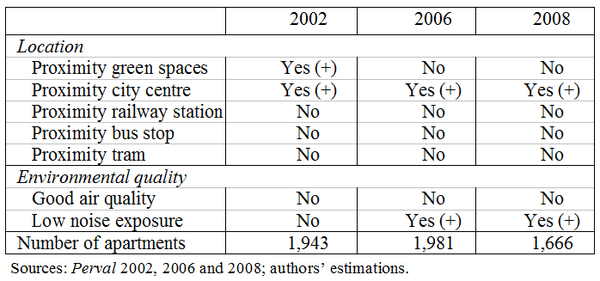Economie et Statistique / Economics and Statistics n° 500-501-502 - 2018 Accessibility, local pollution and housing prices. Evidence from Nantes Métropole, France
THE ARTICLE ON ONE PAGE
Key question
Elected the European Union’s Green capital in 2013, Nantes also ranks at the top of French cities to live in. One of its strengths is its environmental performance, with good urban transport networks, air quality, a quiet environment and green spaces in the city. To what extent do households value these determinants of their living environment? This issue is particularly relevant with respect to the effectiveness of local environmental policies.
Methods
A spatial hedonic price model is estimated using the Perval database. These data provide information on 5,590 apartment transactions in Nantes Métropole in 2002, 2006 and 2008. The data are geo-referenced, and special attention is paid to the construction of environmental quality variables (noise, concentrations of airborne pollutants). Spatial autocorrelation and spatial heterogeneity are taken into account.
Main results
- First, the natural environment of the apartments considered in Nantes Métropole is generally of good quality: 87% of apartments are located less than 600 meters from a green space; apartments are well-served by public transport: 46% are within 2 km of a railway station. 25% have a bus stop less than 100 meters away and 48% have a tram stop less than 500 meters away. About half of apartments are not subject to noise problems (from road and rail) at any point during the day (below 65 dB). Only 15% of apartments suffer from air pollution.
- Apartment prices depend above all on the intrinsic attributes of the dwellings and their socio-economic environment.
- Accessibility to the city center unsurprisingly plays a positive role, but the influence of public transport networks (train, tram and bus) in real-estate capitalization is negligible overall.
- Noise from road and rail is perceived negatively in 2006 and 2008: apartment prices increase when noise levels fall, although the effect sizes are small: for a noise exposure of 55 to 60 dB, our results suggest a lower price of 0.28% per additional decibel.
- Last, the concentration of airborne pollutants has no effect on apartment prices: an improvement in air quality is not seen as a premium by apartments’ purchasers, even for the most polluted ones.
graphiqueInfluence of location and environmental variables on the selling price of apartments in Nantes Métropole

Main message
These results should be treated with some caution, firstly because they relate to a natural environment of good quality. Moreover, the access to street and road networks was not considered as a potential premium, and other factors not taken into account (such as security, the quality of schools, etc.) may influence the perception of the living environment quality. Within these limitations, the results seem to provide little support for sustainable urban mobility plans favoring larger accessibility, unless public authorities aim to raise awareness of the use of virtuous modes of transport. This could be achieved with investments in mobility platforms (including carpooling offers) and a reinforcement in services quality to facilitate daily trips.
Article on one page (pdf, 101 Ko )


